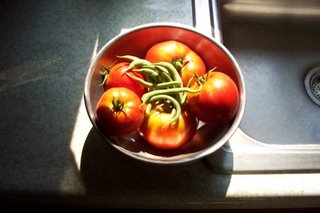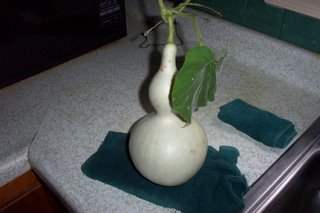
My tomato plants have apparently reached a state of full maturity. Right now there are over 50 tomatos growing on the vine. Additionally, the biggest harvested tomatos are far larger than average, each about a pound in weight.
The String bean plants have yielded their last bit of harvest. The plants themselves were cut down and added to the compost pile. I intentionally left the roots in place because these roots fix nitrogen from the atmosphere into the soil thus making the soil more fertile than before the beans were planted. A week from now the exposed patch of soil will be planted with Kale. This is a cold resistant variety of the cabbage family, and it shall hopefully provide some sustenance during the winter.

During a trip to a neighbor's organic garden, I managed to barter a very unique item, a Chinese Calabash of good stock. The calabash is one of the oldest domesticated plants in the world. It serves the dual purposes of food and container. In this case, I traded 1/2 of all my heirloom squash seeds for 1 single Mature Calabash of around 15 pounds. This plant is very uncommon in the U.S and my neighbor only managed to obtain it from seeds that were passed to him 2 years ago by yet another friend. Apparently, Americans haven't yet developed an appetite for the calabash, nor has the North American environment produced enough pests to attack this plant in earnest. The calabash plants were growing like weeds within my neighbor's garden with no signs of disease or natural predation. As such, Calabash plants may be very easy to grow here in the North East. Needless to say, I shall proceed to consume this calabash and save it's seeds for full scale production next year.
No comments:
Post a Comment